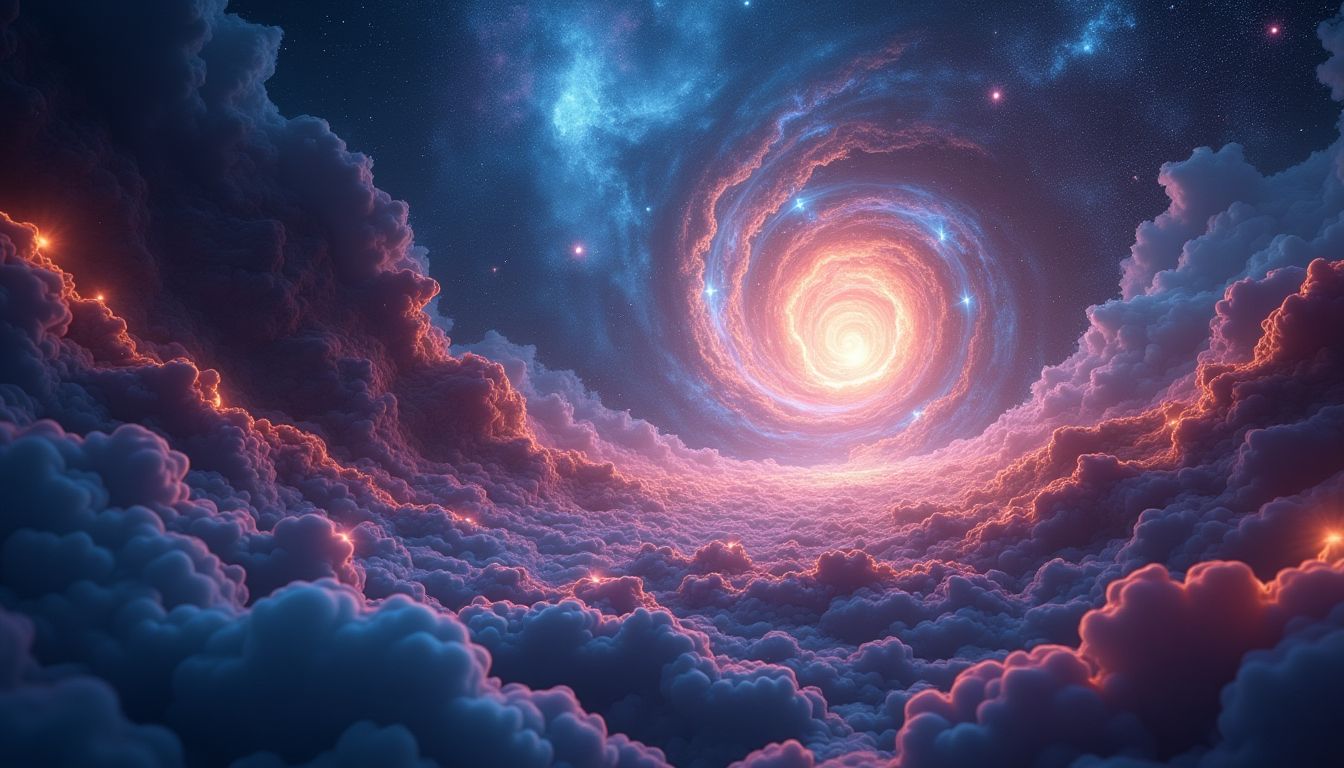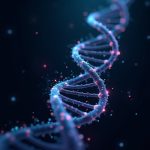What if the deepest secrets of the universe are hiding in plain sight, just beyond the reach of human perception? Scientists estimate that a staggering 95% of the cosmos is composed of dark matter and dark energy—mysterious phenomena that defy our current understanding of physics. Yet, despite decades of research, we have barely scratched the surface of what these invisible forces truly are.
For luminaries like Stephen Hawking, Katie Mack, and Michio Kaku, the quest to understand the dark universe has been an ongoing intellectual battleground. They’ve proposed theories, debated potential explanations, and imagined reality-bending implications of these cosmic ghost particles. But so far, no one has been able to directly observe or explain them. Could we be looking at the problem the wrong way?
Enter artificial intelligence. AI’s ability to sift through massive datasets, recognize complex patterns, and generate predictive simulations is revolutionizing fields from medicine to finance—but what if it could also unlock the greatest mysteries of the universe? By analyzing astronomical observations, running deep-space simulations, and drawing connections beyond human capability, AI might finally be able to shine a light on dark matter and dark energy. If it succeeds, it could completely upend our understanding of the cosmos.
In this article, we’ll explore how AI is being wielded as a tool to decode the physics of the unseen universe. We’ll investigate modern advances in sky-mapping technology, the role of machine learning in astrophysical research, and the potential breakthroughs AI could help us achieve. The nature of reality itself may be at stake.
1. The Enigma of Dark Matter and Dark Energy
Despite decades of astronomical observation, two of the most significant components of the universe remain almost completely unknown: dark matter and dark energy. Together, they account for 95% of the universe’s total composition, yet they remain invisible and resistant to direct study. So, what exactly are they, and why do they challenge everything we thought we knew about physics?
1.1 Defining Dark Matter and Dark Energy
Dark matter and dark energy may sound like something out of a science fiction novel, but they are essential to explaining the universe we observe today.
- Dark Matter: This invisible substance is thought to act as the scaffolding of galaxies, exerting gravitational influence far beyond what normal matter (stars, gas, dust) accounts for. Unlike regular matter, it does not interact with electromagnetic forces, which means it neither emits nor absorbs light—hence the dark in dark matter.
- Dark Energy: If dark matter acts like a cosmic glue, dark energy does the opposite—it accelerates the expansion of the universe. Originally discovered through observations of distant supernovae, dark energy appears to counteract gravity, pushing galaxies away from each other at an ever-increasing rate.
1.2 What We Currently Know (Or Don’t Know)
Despite its theoretical importance, the scientific community has yet to directly detect dark matter particles. The leading candidates—Weakly Interacting Massive Particles (WIMPs), axions, and sterile neutrinos—remain hypothetical, with extensive experiments at facilities like CERN and the LUX-ZEPLIN underground lab still searching for conclusive evidence.
Similarly, dark energy remains an enigma. The primary evidence for its existence comes from supernova redshift measurements and cosmic background radiation studies. The reigning explanation, known as the cosmological constant (Λ), suggests that dark energy is a property of empty space itself. However, competing theories propose concepts like quintessence—dynamic fields that evolve across time.
1.3 Why These Mysteries Matter
Understanding dark matter and dark energy isn’t just an intellectual exercise—it could revolutionize fundamental physics as we know it.
- Physics Overhaul: Current models of physics, including general relativity, do not fully account for these components. Cracking the mystery could force a reevaluation of Newtonian mechanics and Einstein’s theories.
- Cosmology’s Big Questions: The fate of the universe depends on the nature of dark energy. If its repulsion force grows stronger over time, the universe could end in a “Big Rip” scenario where galaxies, stars, and even atoms are torn apart.
- Technological Impact: If dark matter or dark energy principles can be harnessed, it could lead to breakthroughs in quantum mechanics, propulsion technology, and energy generation.
As astronomers struggle to peel back these cosmic layers, AI has emerged as a powerful tool capable of accelerating discoveries. The days of manually sifting through sky maps are over—machines trained on massive datasets might uncover what human eyes have missed.
2. The Role of Data in Modern Astronomy
As we peer deeper into the cosmos, astronomers are drowning in a sea of data. Modern telescopes and satellites generate exabytes of information—far more than any human could analyze in a lifetime. But where human cognition hits a wall, AI thrives, offering new ways to extract meaning from astronomical datasets.
2.1 The Modern Era of Sky Surveys
Humanity has never observed the universe in such detail. Powerful observatories like the Hubble Space Telescope, Gaia mission, and the soon-to-be-operational Vera Rubin Observatory are creating detailed maps of stars, galaxies, and cosmic structures. These instruments are designed to track celestial bodies, measure redshifts, and, most excitingly, identify the gravitational imprints of dark matter.
The challenge? These surveys produce a mind-boggling amount of data. The Sloan Digital Sky Survey (SDSS) has already cataloged over a third of the sky, boasting over 500 million celestial objects. The upcoming Euclid Space Mission is expected to generate petabytes annually, mapping the dark universe with unprecedented precision.
2.2 The Problem with Data Overload
Manually sifting through these gigantic datasets would take decades. AI provides a solution by rapidly sorting, classifying, and identifying anomalies. Deep learning models like convolutional neural networks (CNNs) can scan astronomical images and detect subtle patterns invisible to the human eye.
Take the case of weak gravitational lensing—where the light from distant galaxies bends due to intervening dark matter. This is one of the strongest indicators of dark matter’s presence, but identifying these faint distortions is incredibly difficult. AI-based tools like DeepAI’s Gravitational Lens Identifier automate the process, catching distortions humans miss.
2.3 How AI Supplements Human Shortfalls
AI enhances astronomical research by:
- Processing massive datasets: AI algorithms digest vast quantities of raw data, filtering out cosmic noise and identifying meaningful patterns.
- Detecting anomalies: Algorithms flag unexpected celestial behaviors, such as galaxies behaving contrary to known physics—potential hints of new dark matter interactions.
- Generating predictive models: Machine learning anticipates how celestial bodies interact with dark matter, improving future telescopic observations.
The fusion of deep space surveys and AI analytics is akin to providing astronomers with a high-powered telescope for the unseen universe, making sense of data at a scale and accuracy no human could match alone.
3. AI’s Stellar Strengths: Pattern Recognition and Forecasting
Data alone isn’t enough—pattern recognition is key. AI thrives in this domain, uncovering celestial structures and predicting cosmic phenomena. From mapping galaxy distributions to simulating dark matter dynamics, AI's predictive capabilities could revolutionize our understanding of the universe.
3.1 The Intersection of Astronomy and AI
A new field is emerging: astroinformatics. This fusion of computer science and astronomy leverages machine learning to make sense of celestial complexities. AI tools like Google DeepMind and OpenAI are already extending their neural networks to simulate cosmic events.
For example, deep learning models analyze cosmic microwave background (CMB) radiation, searching for inconsistencies. Abnormal readings could suggest deviations in dark matter distributions, paving the way for transformative discoveries.
3.2 Simulations of the Invisible Universe
Large-scale simulations test hypotheses by modeling cosmic interactions. AI-driven simulations allow astronomers to:
- Recreate early-universe conditions: AI-generated models can track cosmic expansion from the Big Bang to the present.
- Test alternate dark matter theories: AI can create models incorporating axions, WIMPs, or entirely novel particle types.
- Track galaxy formations: Machine learning predicts how gravity influences cosmic structures over billions of years.
Algorithms like NVIDIA’s Pegasus AI are enabling real-time astrophysical models, allowing instant recalibration of theoretical frameworks when new data emerges.
3.3 AI and Anomalous Data Detection
The history of cosmology is filled with chance discoveries—often, anomalies lead to paradigm shifts. AI excels at combing through data and surfacing unexpected phenomena. Recent projects have used neural networks to spot intriguing anomalies in:
- Galactic rotation curves: Deviations in expected speeds of outer stars hint at dark matter’s gravitational effects.
- Supernovae redshift patterns: Variations in cosmic expansion rates may refine our theories of dark energy.
- Cosmic microwave background irregularities: Tiny fluctuations in primordial radiation could reveal exotic physics at play.
The more anomalies AI helps us detect, the closer we get to unraveling the mysteries of the universe—one astronomical oddity at a time.
4. Challenges and Ethics of Using AI to Study the Universe
As artificial intelligence moves deeper into the realm of cosmology, new ethical and technical challenges emerge. Should we trust algorithms to make sense of the cosmos without human oversight? And what happens when AI-generated models conflict with conventional physics? These are no longer hypothetical questions—they’re the next frontier in space research.
4.1 Challenges AI Faces in Astronomy
Even with AI’s immense potential, several roadblocks hinder its effectiveness in astronomy:
- Data quality and completeness: AI systems rely on training data, but astronomical datasets often contain noise, gaps, or inconsistencies. Merging data from telescopes like the Hubble Space Telescope, Gaia, and Vera C. Rubin Observatory can be complex.
- Bias in AI models: Machine-learning models learn from past data. If there are biases in the observational data, an AI could reinforce erroneous cosmological conclusions.
- Interpretable decision-making: AI models, especially deep learning networks, function as “black boxes.” If an AI predicts a new dark matter interaction, how do we verify its accuracy?
- Extreme complexity: Cosmology involves higher dimensions, exotic physics, and probabilistic models. AI must navigate these challenges without oversimplifying theories.
4.2 Missing Human Insight?
For centuries, breakthroughs in physics emerged from human creativity—Einstein's thought experiments, Stephen Hawking’s black hole radiation theories, and Isaac Newton's classical mechanics. AI lacks human intuition, and that poses a risk.
Some possible risks:
| Risk | Impact |
|---|---|
| Reducing human involvement | Physicists may become overly dependent on AI models, leading to a loss of hands-on theoretical exploration. |
| AI-generated errors | Misinterpretation of cosmic phenomena could mislead space missions or research funding. |
| Philosophical dilemmas | Does knowledge created without human input still expand human consciousness? |
Ultimately, AI should act as a collaborative tool for physicists rather than a replacement for human curiosity. But as it grows more sophisticated, where do we draw the line?
5. Breakthroughs AI Could Deliver in Dark Matter & Energy Research
Despite challenges, AI holds the power to transform our understanding of dark matter and dark energy. Imagine a future where AI models “discover” hidden cosmic structures, or where machine learning aids in confirming the existence of new particles.
5.1 Revolutionizing Our Understanding of Dark Matter
Scientists have long speculated about the nature of dark matter, but AI could supercharge these investigations by enhancing computational models and data simulations.
Predicted AI-driven discoveries:
- Developing highly refined maps of dark matter’s gravitational influence using AI-assisted analysis of Chandra X-ray Observatory data.
- Simulating potential dark matter “hot spots” in the universe to guide telescope observations.
- Decoding particle interactions in underground experiments such as LUX-ZEPLIN, increasing the chances of detecting weakly interacting massive particles (WIMPs).
5.2 Solving the Mystery of Dark Energy
Dark energy—responsible for the accelerating expansion of the universe—remains one of astrophysics’ biggest enigmas. AI comes into play by refining previous models and generating new hypotheses.
Key AI applications in dark energy research:
- Enhancing precision in measuring supernova brightness and redshift values, reducing observational uncertainties.
- Running thousands of universe-scale simulations to compare different dark energy models (quintessence vs. cosmological constant theories).
- Unveiling cosmic expansion trends with deep learning predictions, possibly rewriting our understanding of universal fate.
5.3 Unifying Theories
Could AI be the bridge between quantum mechanics and cosmology? A long-sought “Theory of Everything” might emerge from AI-driven insights.
Entire astrophysics paradigms hinge on resolving tensions between:
- Quantum entanglement and general relativity.
- The behavior of dark matter within black hole singularities.
- How dark energy might interact with the fabric of space-time.
AI-powered models could test hypotheses far beyond human cognitive limitations, leading to theoretical breakthroughs in gravitational waves, cosmic inflation, and multidimensional physics.
The possibilities are endless, and the universe is waiting to be decoded.
6. AI Solutions: How Would AI Tackle This Issue?
Artificial Intelligence isn't just an optimization tool anymore—it's a paradigm shift. If we truly want to decode dark matter and dark energy, we need AI-driven strategies that integrate data across disciplines, construct predictive models, and run high-fidelity simulations faster than any human mind could. What would an AI-led discovery effort look like? Here’s a roadmap.
6.1 Dataset Integration: Merging the Cosmic Puzzle
The universe doesn't come with neatly labeled datasets. AI’s first role would be to unify disjointed repositories from multiple instruments and disciplines, creating a coherent database that humans can use for analysis.
- Observational Astronomy Datasets: AI-driven data fusion would integrate observations from James Webb Space Telescope, Gaia, and Vera Rubin Observatory.
- Particle Physics Experiments: AI can bridge gaps between CERN's LHC data and dark matter direct detection results from LUX-ZEPLIN.
- Natural Language Processing (NLP) for Research: AI-powered NLP models could parse the vast body of existing scientific literature, automatically identifying overlooked patterns or alternative hypotheses.
6.2 AI-Driven Hypothesis Testing: Making Sense of the Chaos
Instead of relying solely on traditional hypothesis-driven research, AI can autonomously generate and test thousands of theories based on existing and incoming data.
- Reinforcement Learning Models: Systems like AlphaFold (which revolutionized protein folding predictions) could be adapted to cosmology, training models to predict how dark matter interacts with gravity over billions of years.
- AI Detecting Axion Signatures: Potential dark matter candidates like axions could be identified through AI-based pattern recognition in CMB radiation distortions.
- Dark Energy Simulators: Neural networks equipped for manifold mapping could generate energy distribution maps based on supernova redshift observations.
6.3 Automated Predictive Simulations
AI can run multiverse-scale simulations in ways human researchers never could. These simulations can iteratively refine their own physics models, aligning them more closely with observed cosmic data.
- Deep Learning Simulations: DeepMind’s artificial intelligence, which mastered Starcraft, could also be deployed to build real-time simulations of galactic evolution.
- Neural Boltzmann Solvers: AI could process the massive statistical mechanics equations that govern cosmic evolution, thwarting bottlenecks that cripple human analysis.
- Cosmic Ray Data Models: Leveraging data from NASA’s Fermi Gamma-ray Space Telescope to detect residual dark matter interactions.
6.4 Real-Time Adaptive AI in Cosmology Research
Why stop at simulations? AI should continuously adapt and refine its discoveries by testing them against live-streaming data from telescopes across the world.
- Meta-Learning AI: AI will not only analyze results but also determine which questions are worth answering next, optimizing human efforts in research.
- Interactive Holographic Models: Sci-fi comes to life—scientists could interact with dynamically shifting, AI-simulated projections of the evolving universe.
ACTIONS SCHEDULE: A Roadmap for AI-Led Dark Matter Discoveries
| Timeline | Objective | Key Institutions |
|---|---|---|
| Day 0 | Register domain: moonshot-project.com. Establish subdomains for experts to share research. | NASA, ESA, OpenAI |
| Day 1 | Assemble an interdisciplinary task force: astrophysicists, AI scientists, mathematicians. | CERN, MIT, Caltech |
| Week 1 | Cluster computing power from OpenAI, Google DeepMind, and NVIDIA for AI simulations. | OpenAI, Google, NVIDIA |
| Week 2 | Draft the AI-powered "Cosmic Synthesis" system white paper. Research grant proposals. | National Science Foundation, Max Planck Institute |
| Month 1 | Develop pilot AI models for weak gravitational lensing detection. | NASA Goddard, European Space Agency |
| Month 2 | Launch GPU-intensive AI training using data from the Webb Telescope. | NVIDIA, Tesla AI |
| Year 1 | Test AI’s hypothesis-driven discoveries against real-world astronomical observations. | Harvard-Smithsonian Center for Astrophysics |
Unlocking the Universe’s Deepest Secrets with AI
Dark matter and dark energy—these two phenomena dictate the fate of the cosmos, yet we've barely scratched the surface of understanding them. For centuries, humanity has relied on intuition, reason, and raw computational power to make sense of the void. Now, artificial intelligence offers a fundamentally new way to approach these enigmas, providing an avenue to unify cosmological theory with physical experimentation.
AI can process the unfathomable datasets generated by telescopes, run simulations at unimaginable speeds, and blend multi-disciplinary research into a cohesive framework. The transformation isn’t just theoretical—it has already begun. In just the past decade, machine learning algorithms have started identifying unknown cosmic structures, refining gravity lensing calculations, and even spotting anomalies in astronomical observations that might hint at these dark forces at play.
But there’s an even bigger question looming: If AI succeeds in unraveling the nature of dark matter and dark energy, what’s next? Could it lead to humanity unlocking new forms of energy, opening pathways for intergalactic travel, or even challenging the fundamental laws of physics as we understand them? What happens when an artificial intelligence—something built by humans but capable of thinking beyond human limitations—lays bare the cosmic blueprint?
If these discoveries come in our lifetime, will we be prepared? Will we accept the answers AI provides, even if they contradict long-held beliefs about space, time, and our place in the universe? The future beckons, and AI is at the helm.
Let’s hear your thoughts: Do you believe AI will be the key to unlocking the mysteries of dark matter and dark energy, or do you think human intuition still has a role AI can never replace? Drop a comment below and join the debate.
Subscribe to our newsletter to get a front-row seat to future cosmic revelations and be part of iNthacity: the "Shining City on the Web"!
Frequently Asked Questions
What is dark matter and why is it important?
Dark matter is an unseen substance that makes up about 27% of the universe, yet it does not emit, absorb, or reflect light like ordinary matter. Its presence is inferred through gravitational effects on visible matter, such as the way galaxies rotate much faster than they should based on visible mass alone. Understanding dark matter could revolutionize our comprehension of fundamental physics, leading to breakthroughs in cosmology, quantum mechanics, and even futuristic technologies like exotic energy sources.
How does AI help in the search for dark matter?
AI is playing a crucial role by analyzing vast amounts of astronomical data, detecting patterns too subtle for human observation, and running complex simulations that test different theories of dark matter composition. Companies like DeepMind and institutions like CERN are leveraging machine learning models to interpret cosmic microwave background radiation, map gravitational lensing effects, and identify probable locations of dark matter clusters.
What’s the difference between dark matter and dark energy?
While dark matter is the mysterious invisible mass holding galaxies together, dark energy is the force driving the accelerated expansion of the universe. Dark energy accounts for about 68% of the cosmos and currently defies full scientific understanding. Recent observations suggest it may either be a new fundamental force of nature or a correction to Einstein's equations of gravity.
What AI techniques are used in astrophysics research?
Several advanced AI methods are being applied in astrophysics:
- Machine Learning: AI systems trained on astronomical datasets detect hidden structures within cosmic maps.
- Neural Networks: Algorithms like convolutional neural networks (CNNs) help recognize gravitational distortions caused by dark matter.
- Reinforcement Learning: AI optimizes simulations by iterating through different theoretical models to predict missing cosmic components.
- Natural Language Processing (NLP): AI scours scientific literature to identify new unexplored dark matter hypotheses, effectively acting as a virtual research assistant.
Could discovering dark matter lead to new technologies?
Absolutely. Just as past breakthroughs in physics—from relativity to quantum mechanics—paved the way for nuclear energy, GPS, and semiconductors, unlocking dark matter’s secrets might open doors to revolutionary tech. Potential applications could include:
| Potential Discovery | Real-World Impact |
|---|---|
| Controlling exotic particles | New forms of energy leveraging unknown physics |
| Understanding quantum effects of dark matter | Improved quantum computing and cryptography |
| Warped space manipulation | Potential stepping stone to faster-than-light travel |
Are scientists any closer to directly detecting dark matter?
Physicists around the world are working tirelessly to detect dark matter directly through large underground detectors like the LUX-ZEPLIN experiment or the XENON dark matter project. These experiments attempt to capture rare interactions between dark matter particles and ordinary matter. AI is aiding this effort by filtering out noise and false positives, increasing the likelihood of identifying a real dark matter signal.
Is AI capable of replacing human cosmologists?
Not at all. AI serves as an invaluable tool in analysis and prediction, but human ingenuity is essential for interpreting new discoveries and formulating theoretical models. The collaboration of AI and human researchers creates an accelerated scientific process, but AI lacks the creativity and intuition that led to breakthroughs by figures like Stephen Hawking or Albert Einstein.
What are the biggest challenges AI faces in dark matter research?
Despite its advantages, AI still faces substantial challenges in astrophysics:
- Data Gaps: Many cosmic observations are incomplete, and missing data can limit AI effectiveness.
- Algorithmic Bias: AI models can produce misleading conclusions if trained on flawed or narrow datasets.
- Computational Limits: Simulating an entire universe with quantum-level precision remains beyond today’s AI and computing power, though quantum computing advances may help bridge this gap in the future.
How can the average person contribute to dark matter research?
Citizen science projects allow anyone to participate in astronomical discoveries. Platforms like Galaxy Zoo empower the public to classify galactic structures, aiding AI in training datasets. Additionally, organizations such as SETI@Home let individuals donate computer processing power to assist in large-scale extraterrestrial research and cosmic data analysis.
Could AI eventually help us understand the true nature of reality?
This is the million-dollar question. AI has already transformed physics research by accelerating theories of quantum gravity, black hole dynamics, and extra-dimensional models. Some researchers speculate that if AI continues advancing, it may uncover unconventional physics suggesting our universe is part of a larger multiverse—potentially rewriting the very nature of reality itself.
What mysteries of the cosmos fascinate you the most? Do you think AI will finally crack the enigma of dark matter and dark energy? Share your thoughts in the comments below!
Wait! There's more...check out our gripping short story that continues the journey: The Algorithm and the Abyss
Disclaimer: This article may contain affiliate links. If you click on these links and make a purchase, we may receive a commission at no additional cost to you. Our recommendations and reviews are always independent and objective, aiming to provide you with the best information and resources.
Get Exclusive Stories, Photos, Art & Offers - Subscribe Today!





























Post Comment
You must be logged in to post a comment.